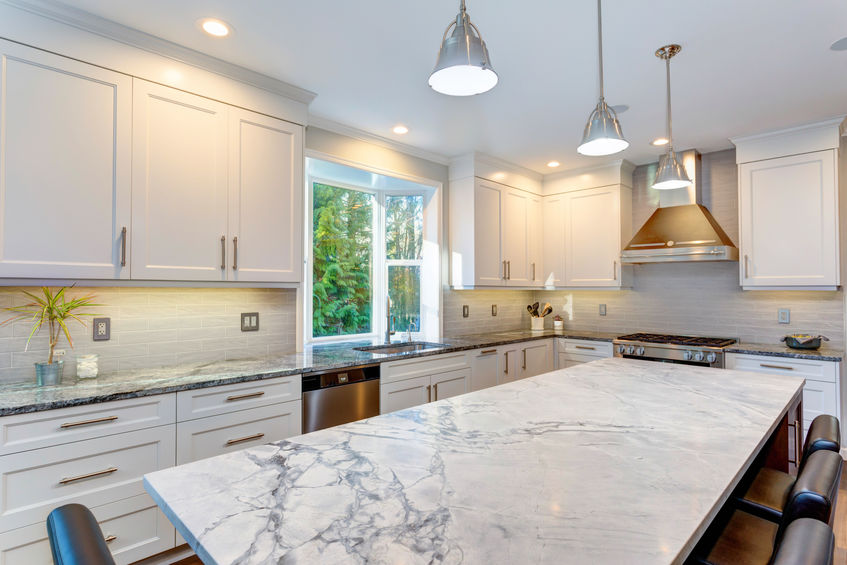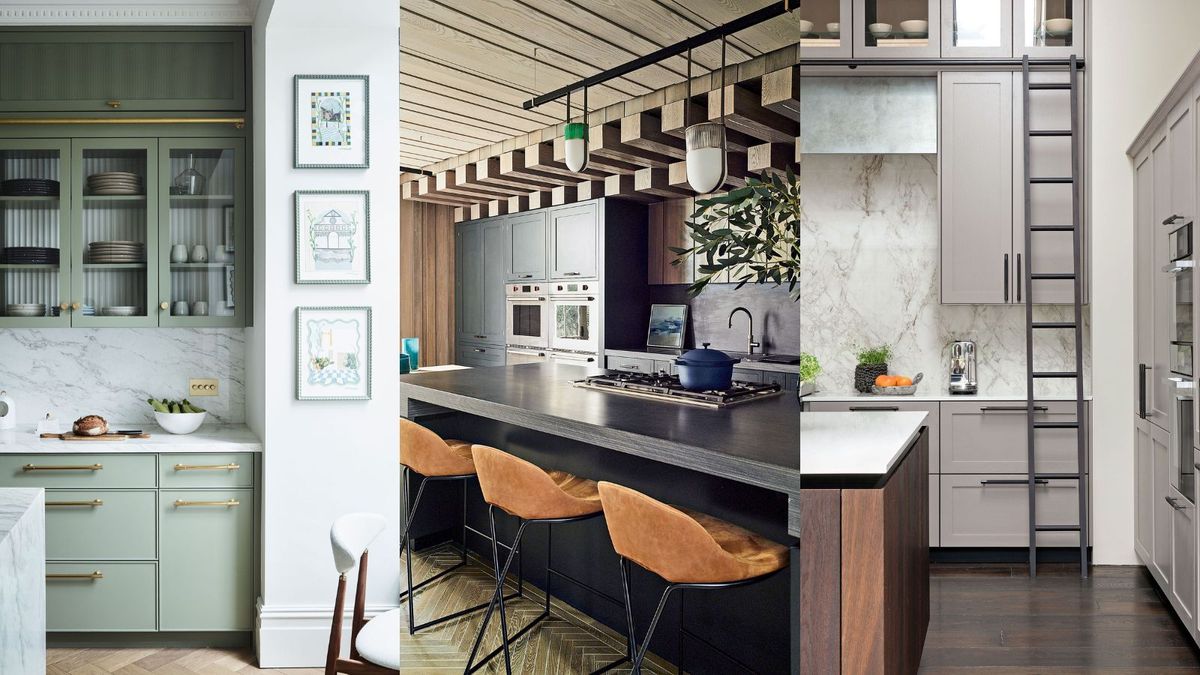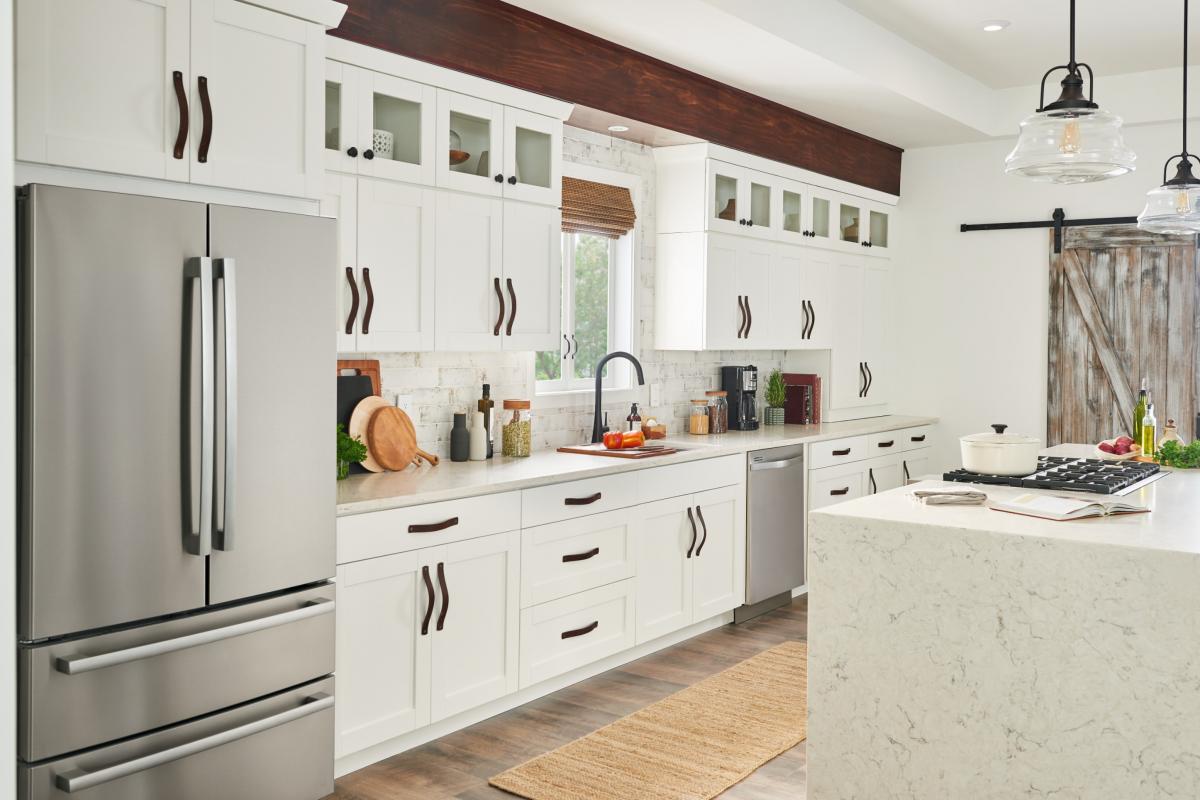Aesthetic Considerations

The decision to extend your kitchen cabinets to the ceiling can significantly impact the visual appeal of your space. Ceiling-height cabinets offer a sleek and modern look, creating a sense of order and maximizing storage potential. However, they can also alter the proportions of the room, potentially making it feel smaller or more imposing depending on the design and layout.
Impact of Cabinet Styles on Visual Appeal, Should kitchen cabinets go to ceiling
The style of your cabinets plays a crucial role in how ceiling-height cabinets integrate into your kitchen’s overall aesthetic.
- Shaker cabinets, with their simple and clean lines, often blend seamlessly with the ceiling, creating a streamlined and minimalist look. This style is particularly effective in smaller kitchens where maximizing vertical space is essential.
- Modern cabinets, known for their sleek, geometric forms and lack of ornamentation, can also benefit from reaching the ceiling. This approach emphasizes the clean lines and modern aesthetic, creating a sense of spaciousness and sophistication.
- Traditional cabinets, with their intricate details and ornate hardware, might appear overwhelming when extended to the ceiling. The abundance of visual elements can make the space feel cluttered and less cohesive. However, when carefully planned and executed, traditional cabinets can still create a striking and elegant effect.
Examples of Enhanced Elegance and Functionality
Ceiling-height cabinets can transform a kitchen into a visually stunning and highly functional space.
- Open shelving integrated into the upper cabinets can create a dramatic and airy effect, particularly when combined with a minimalist design. This approach allows for the display of decorative items and glassware, adding a touch of personality to the space.
- Integrated appliances, such as a microwave or oven, seamlessly blend into the cabinet design, creating a clean and uncluttered look. This approach enhances the functionality and efficiency of the kitchen while maintaining a visually cohesive aesthetic.
- Consistent color and finish throughout the cabinet design, from floor to ceiling, creates a sense of unity and visual flow. This approach emphasizes the verticality of the space, making it appear larger and more balanced.
Pros and Cons of Ceiling-Height Cabinets Based on Aesthetics
| Feature | Pros | Cons |
|---|---|---|
| Visual Impact | Creates a clean, modern, and streamlined aesthetic. Maximizes vertical space, making the kitchen appear larger. Provides a sense of order and organization. | Can make the kitchen feel smaller or more imposing, especially in smaller spaces. May create a sense of “boxed in” if not designed carefully. Can accentuate imperfections in the ceiling. |
| Cabinet Style | Shaker and modern styles tend to blend seamlessly with the ceiling, creating a cohesive look. Traditional styles can be effective if carefully planned and executed. | Traditional styles can appear overwhelming and cluttered when extended to the ceiling. |
| Functionality | Maximizes storage space. Allows for the integration of appliances, creating a streamlined and efficient kitchen. | May require a ladder or step stool for access to upper shelves. Can be difficult to clean the top of the cabinets. |
Practical Advantages and Disadvantages: Should Kitchen Cabinets Go To Ceiling

Taking your kitchen cabinets all the way to the ceiling offers a wealth of practical benefits, but it also presents some challenges that are worth considering. This section will explore the advantages and disadvantages of this design choice to help you make an informed decision for your kitchen.
Maximizing Storage Space
Ceiling-height cabinets are a game-changer when it comes to maximizing storage space. By utilizing the often-neglected vertical space, you can create a significant increase in storage capacity. This is particularly beneficial in smaller kitchens where every inch counts.
- Increased Storage Capacity: By utilizing the vertical space, you can store more items without sacrificing valuable floor space. This can be especially helpful for storing items that are used less frequently, such as seasonal dishes, extra appliances, or bulky items like baking sheets and pots.
- Organized and Tidy Kitchen: With more storage space, you can keep your kitchen organized and clutter-free. This can create a more pleasant and efficient cooking and dining experience.
- Reduced Clutter: By maximizing storage, you can minimize clutter on countertops and in drawers, creating a more streamlined and visually appealing kitchen.
Accessibility Challenges
While ceiling-height cabinets offer increased storage, accessing items stored in these high cabinets can be challenging.
- Step Stools or Ladders: Reaching items stored in high cabinets often requires the use of step stools or ladders, which can be inconvenient and potentially dangerous, especially for individuals with mobility limitations.
- Specialized Tools: Some items may be difficult to reach even with a step stool, requiring the use of specialized tools like reachers or grabber tools. This can add an extra layer of complexity and inconvenience to the storage process.
- Safety Considerations: Using step stools or ladders can pose safety risks, especially if not used properly. It’s essential to ensure that the equipment is sturdy and in good condition and that the user is comfortable and confident using it.
Optimizing Ceiling-Height Cabinets for Efficient Storage
Despite the challenges of accessing items in high cabinets, there are strategies to optimize their use for efficient storage solutions.
- Organize by Frequency of Use: Store items you use frequently in lower cabinets, while less frequently used items can be placed higher up. This reduces the need to reach for items that are rarely used.
- Utilize Pull-Down or Lift-Up Mechanisms: Consider incorporating pull-down or lift-up mechanisms in your high cabinets. These mechanisms allow you to easily access items stored high up without the need for a step stool or ladder.
- Labeling and Organization: Label your cabinets clearly and organize items within them to ensure you can easily find what you need. This can be especially helpful for high cabinets where visibility is limited.
Practicality in Different Kitchen Layouts and Sizes
The practicality of ceiling-height cabinets can vary depending on the size and layout of your kitchen.
- Small Kitchens: In smaller kitchens, maximizing vertical space is crucial. Ceiling-height cabinets can significantly increase storage capacity, making them a practical choice for maximizing efficiency.
- Large Kitchens: In larger kitchens, ceiling-height cabinets may not be as essential. However, they can still be a valuable addition for storing items that are not used frequently or for creating a more cohesive and streamlined look.
- Open-Concept Kitchens: If your kitchen is open to other living spaces, ceiling-height cabinets can create a sense of visual continuity and contribute to a more unified aesthetic.
Installation and Cost Considerations

Installing ceiling-height cabinets is a more involved process than installing standard-height cabinets, requiring specialized tools, expertise, and careful planning. This section delves into the intricacies of installation, compares the cost of ceiling-height cabinets with standard-height cabinets, and analyzes the long-term cost benefits of maximizing storage space.
Installation Process
Installing ceiling-height cabinets requires a meticulous approach, involving specific tools and expertise. The process typically involves:
- Precise Measurements: Accurate measurements of the space are crucial for ensuring a perfect fit and avoiding costly mistakes. This step is critical, as any errors can lead to significant adjustments during installation.
- Cabinet Preparation: Prior to installation, cabinets need to be assembled and adjusted to fit the designated space. This step involves assembling the cabinet boxes, attaching doors and drawers, and ensuring proper alignment for seamless integration.
- Wall Preparation: Walls must be properly prepared to support the weight of the cabinets. This may involve reinforcing the existing structure, ensuring that the walls are plumb and level, and providing adequate support for the weight of the cabinets.
- Cabinet Installation: Installing the cabinets involves carefully securing them to the wall using specialized hardware. This step requires precision and expertise to ensure that the cabinets are installed securely and level. The process typically involves using screws, brackets, or other specialized hardware designed for heavy-duty applications.
- Finishing Touches: Once the cabinets are installed, finishing touches, such as adding trim, installing hardware, and adjusting doors and drawers, are essential for a professional and functional outcome. These final steps complete the installation process and ensure that the cabinets are ready for use.
Cost Comparison
The cost of installing ceiling-height cabinets can vary significantly depending on factors such as the size of the kitchen, the complexity of the installation, the materials used, and the labor costs.
- Materials: Ceiling-height cabinets generally require more materials than standard-height cabinets, as they need to be taller and may require additional components, such as crown molding or decorative accents. The cost of materials can vary significantly depending on the type of wood, the finish, and the complexity of the design.
- Labor: Installing ceiling-height cabinets is more labor-intensive than installing standard-height cabinets. This is due to the increased height, which requires specialized tools, expertise, and additional time for installation. Labor costs can vary significantly depending on the location, the experience of the installer, and the complexity of the project.
- Modifications: If the existing kitchen layout requires significant modifications, such as electrical work, plumbing adjustments, or structural changes, these costs can add significantly to the overall project cost. The extent of these modifications will determine the additional labor and materials needed, directly impacting the overall expense.
Cost and Installation Complexity
The following table summarizes the pros and cons of ceiling-height cabinets in terms of cost and installation complexity:
| Feature | Ceiling-Height Cabinets | Standard-Height Cabinets |
|---|---|---|
| Installation Complexity | More complex, requiring specialized tools and expertise | Less complex, typically easier to install |
| Material Costs | Higher due to more materials and potentially more complex designs | Lower due to less material and simpler designs |
| Labor Costs | Higher due to increased labor time and specialized expertise | Lower due to less labor time and less specialized expertise |
| Long-Term Cost Benefits | Maximizes storage space, reducing the need for additional storage solutions, potentially saving money in the long run | May require additional storage solutions, potentially increasing costs in the long run |
Long-Term Cost Benefits
While the initial cost of installing ceiling-height cabinets may be higher, the long-term cost benefits can outweigh the upfront investment. By maximizing storage space, ceiling-height cabinets can help reduce the need for additional storage solutions, potentially saving money in the long run.
For example, consider the cost of purchasing and storing items in off-site storage units. This expense can be significantly reduced by maximizing storage space within the kitchen, minimizing the need for external storage solutions.
Additionally, ceiling-height cabinets can help to increase the resale value of a home by creating a more organized and functional kitchen space. This can be a significant factor for potential buyers, leading to a higher selling price and a faster sale.
Should kitchen cabinets go to ceiling – The decision to extend kitchen cabinets to the ceiling is a matter of both aesthetics and practicality. While maximizing storage space is a significant benefit, the choice of cabinetry material plays a crucial role. For those seeking longevity and timeless appeal, solid wood kitchen cabinets UK offer a superior option.
Their durability and inherent beauty complement the clean lines of ceiling-height cabinets, creating a cohesive and sophisticated kitchen design. Ultimately, the choice depends on personal preferences and the overall style of the space.
The decision of whether to extend kitchen cabinets to the ceiling is a matter of both aesthetic preference and practical considerations. While maximizing storage space is a significant benefit, it’s essential to consider the overall design flow. Incorporating gold kitchen cabinet hardware can add a touch of elegance and sophistication, further enhancing the visual appeal of the cabinetry.
Ultimately, the choice should be driven by the specific needs and style of the kitchen, ensuring a cohesive and functional space.
